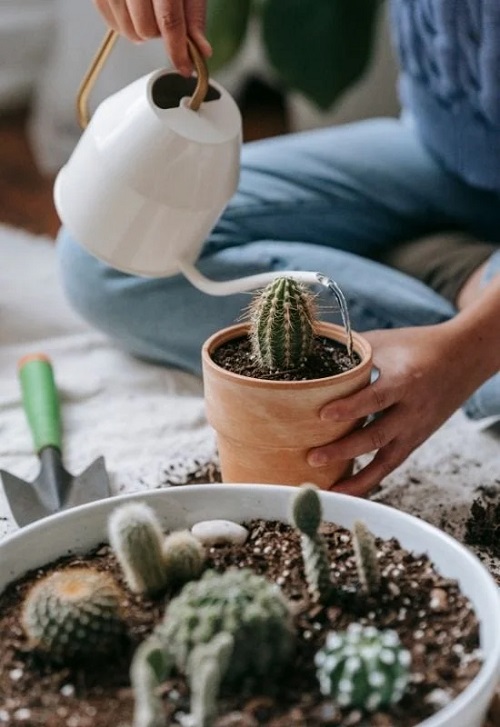How to Tell if a Cactus is Dying? Find here the key signs that indicate your cactus is unwell and learn how to revive it.

If you are thinking “Why is my cactus dying?” determining a cactus’s health can sometimes be challenging. In this guide, we will tell you the subtle signs that suggest your cactus might need urgent care. Plus, you will understand whether your cactus is simply going through a rough patch or if it’s signaling a more serious condition, providing practical advice on how to nurture it back to vitality.
How to Tell if a Cactus is Dying?

The appearance of your cactus will tell you about its health conditions. If your cactus is firm to the touch, showing a vibrant green color, the spines are firm and intact with each other, new growth is emerging, and the roots are white while displaying firmness, then it represents a healthy cactus. But if it’s showing signs opposite to these, then there is a possibility that your cactus is dying. Read below to learn about the indicators of an unhealthy/dying cactus.
1. Check the Smell of Your Cactus
If your cactus smells foul, it indicates that a large portion of the plant has succumbed to rot. This may be because you were overwatering, which led to rooting. Now, it will hardly recover, so the best solution is to remove the cactus and start again.
2. The Cactus is Looking Wobbly
As you know, cacti are slow-growing succulent plants known for their firmness. If you see them losing their core nature, that is, rotten roots, breaking off spines easily, and brown, red, and black leaves. These signs indicate that your cactus is nearing death.
3. The Cactus is Displaying Discoloration
Cacti are drought-tolerant, desert-dwelling plants that thrive in arid conditions. However, lack of irrigation is the most common and deadly reason for cacti’s decline. They will show a brown base, turning yellow; in such cases, it’s hard to save a cactus.
4. You Observe Soft and Mushy Texture
A healthy cactus should feel firm and rigid. If it feels soft or mushy, it’s often a sign of excessive moisture and root rot which will eventually lead to decay.
5. Rotting Base or Roots in Cactus
A rotting base or roots, often soft and blackened, is a critical sign of overwatering and root rot, which is a common cause of cactus death.
6. Leaf and Spine Drop in Cactus
If your cactus is dropping leaves or spines excessively, it could be under stress from improper lighting, incorrect watering, or nutrient deficiencies. So, you must fix it to save its life!
7. You Observe Stunted Growth
Stunted or slowed growth can indicate poor soil conditions, inadequate lighting, or a compromised root system. If the situation continues for long, it can lead to the death of the cactus.
8. Signs of Shriveling in Cactus
While some wrinkling is normal during drought, excessive shriveling indicates a lack of water or a damaged root system that cannot absorb water effectively.
When talking about succulents, there is a very fine line between overwatering and underwatering. So, whenever you notice wrinkles on your cactus, irrigate it to safeguard it from a shriveled texture.
9. Spots and Blemishes in Cactus
Look for unusual spots caused by physical damage, blemishes, or growths on the cactus. These can be symptoms of fungal infections or pest infestations.
Saving Your Dying Cactus: Simple Tips

Here are some easy tips will help you figure out what’s wrong and how to save it before it’s too late.
Fixing Overwatered or Rotting Cactus
If your cactus has browning or blackening leaves or stems, and they feel soft and mushy, it might be overwatered. Here’s what to do—unpot the cactus by wrapping it in newspaper and tipping it out. Check the roots. If they are black and mushy, cut away the bad parts.
If the rot is extensive, you’ll need to reroot the cactus by cutting away all the rot using a sharp, clean knife. Let the cactus dry for several days until thick scabs form on the cuts. Repot the cactus using cactus or succulent soil. Remember to water your cactus only when the top 1-2 inches of soil are dry and always throw away excess water from the saucer.
Rehydrating an Underwatered Cactus
Is your cactus discolored, dry, or wilting? It might be underwatered. Then, give it a good soak of water early in the morning. Move it to a spot with indirect sunlight. If it doesn’t bounce back after a few days, try water therapy as a last resort.
Tip: Ensure your cactus pot has drainage holes to prevent water from sitting at the bottom, which can lead to root rot.

Treating a Sunburned Cactus
Yellow or white marks on your cactus mean it’s getting sunburned. Immediately, you need to move it to a shaded area. Leave the sunburned parts alone to heal themselves. Reduce watering during this time and check for pests and diseases.
Helping a Cactus with Cold Damage
Cold weather can soften or whiten your cactus, turning it black and decayed. Here’s how to help—wait until the softened areas turn black. In the spring, snip off the black parts to help your cactus heal and grow new parts.
Fact: Some cactus species are more cold-tolerant than others. Knowing your cactus type can help you provide better care.
Providing Proper Light for Etiolated Cactus
If your cactus is growing tall and skinny with a pale color, it needs more light. Move it to a brighter spot, like a south-facing window. Plus, Rotate your cactus regularly to ensure even light exposure and prevent leaning. This will help it grow properly again.
By paying close attention to your cactus’s needs and following these simple tips, you can keep it healthy and thriving. Have you faced any unique challenges or have extra advice on saving a cactus? Share your experiences and tips to help other cactus lovers!






